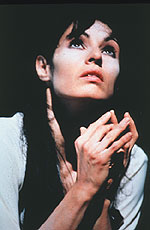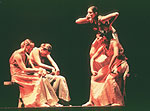French ballet has always been a man’s world, choreographically-speaking, ever since Louis XIV set up the Paris Opera and started a precedent becoming its first director/choreographer/star dancer… and sponsor. Women choreographers have had a much easier time with the more laid-back contemporary dance scene, which initially sought inspiration from barefoot pioneer Isadora Duncan. Few have headed a classical repertory company.
That’s perhaps one of the reasons why Marie-Claude Pietragalla — back in town with her new production“Sakountala” at the Palais des Congrès — took a major risk in 1998, leaving the Paris Opera and accepting an offer to direct the Ballet National de Marseille, founded in 1972 by Roland Petit. Pietragalla, who had been with the Paris Opera since 1979 and was at the height of her career, stood out for her versatility and openness to performing works by moderns, such as William Forsythe, Robert Wilson and Carolyn Carlson.
Only six years away from mandatory retirement, she was ready for a change. The transition was rough, but Pietragalla’s Corsican temperament and determination have served her well. In spite of Roland Petit’s veto and his refusal to let the company perform his works, she took the bull by the horns and has built up an exciting new classical and contemporary repertoire from scratch with many newly hired dancers eager for a challenge. And now Parisians will finally have a chance to see the new Ballet National de Marseille for themselves.
Inspired by the tragic destiny of sculptress Camille Claudel,“Sakountala” is Pietragalla’s third creation for her adopted company. “I didn’t want to choreograph a romanced biography of Camille Claudel. I want to talk about a woman who sculpts,” said Pietragalla/Camille Claudel, in a recent press statement. “Sculptors give shape to their stones, day by day, just as dancers sculpt their bodies. I feel very close to Claudel because all artists are fragile and afraid of being misunderstood.”
Camille Claudel, born in 1864, was another woman ahead of her times, who tried in vain to gain recognition in a man’s world. As Auguste Rodin’s mistress, model and devoted pupil, her works, such as “La Valse,” “Les Causeuses,” and “Sakountala” (or “The Abandon”) based on an Indian legend of two lovers whose conflicting karma keeps them apart until they’re reunited in nirvana, began to rival and even surpass her mentor’s. She often helped Rodin to complete his own works without getting due credit for it. She was committed into a mental asylum in 1913 where she stayed for 30 years until her death, never creating another work of art again.
With an original score by Pierre-Alexandre Mati reflecting Claudel’s joys and torments, circus artists conveying a sense of illusion amid reality, and a sculpture-like decor by Philippe Plancoulaine, Pietragalla probes that nebulous place between genius and madness.
“Sakountala” (Chor. Marie-Claude Pietragalla/Music Pierre-Alexandre Mati), Ballet National de Marseille, with circus artists directed by Katrin Wolf, Apr 6, 8, 10, 11 & 12 at 8:30pm, Apr 7 & 14 at 2:30pm, Apr 13 at 2:30pm and 8:30pm, Palais des Congrès, pl de la Porte Maillot, M° Porte Maillot, tel: 01 40 68 00 05





